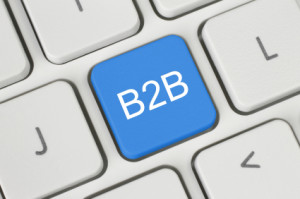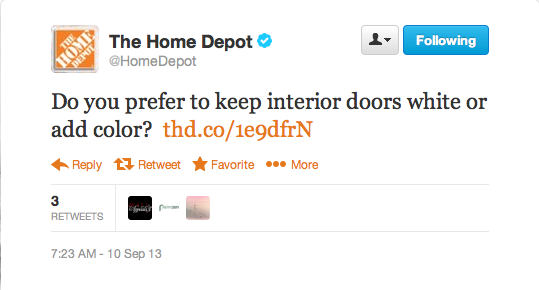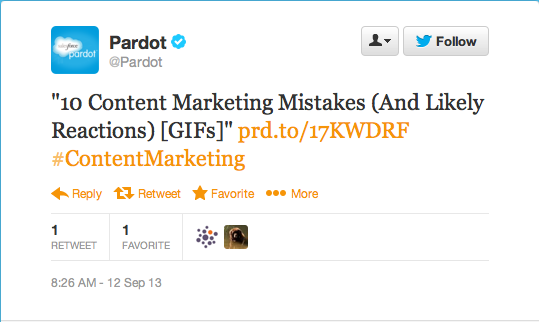by gabriel_sales | Sep 18, 2013
 Generating leads for business to business companies is no longer as simple as attending a trade show or advertising in an industry trade magazine. Business to business lead generation now requires reaching your prospects online and offering them quality marketing content to engage with in exchange for their contact information.
Generating leads for business to business companies is no longer as simple as attending a trade show or advertising in an industry trade magazine. Business to business lead generation now requires reaching your prospects online and offering them quality marketing content to engage with in exchange for their contact information.
A mature business to business lead generation strategy is comprised of three parts: digital content marketing, search engine optimization and marketing automation. These three aspects are interrelated and success in implementing one will ultimately lead to success with the others. We will now give a brief overview of each aspect and discuss how they work together.
- Digital Content Marketing
In order to generate a lead, you need to get your prospect’s contact information. In order to get your prospect’s contact information, you need to offer something in exchange. That something is marketing content. What form the marketing content takes can vary greatly (i.e. blog posts, press releases, newsletters, white papers, webinars, videos, slideshows, checklists, etc.), but it needs to be valuable in some way to your ideal customer. People find things valuable that are entertaining, helpful, newsworthy or inspirational. Most of your B2B content will find value in its helpfulness, so checklists, educational webinars and informative white papers are a good place to start.
2. Search Engine Optimization
The amazing digital marketing content you create will do you no good unless people can find it. This is where intelligent SEO comes in. In order to make sure search engines like Google can find your content and get it to your prospects for lead generation, you need to optimize each piece of content you create with the most relevant and regularly searched keywords. You also need to optimize your website’s infrastructure to make it easier for search engines to navigate your site quickly (i.e. pagination, categorization, tagging).
3. Marketing Automation
While not a B2B lead generation strategy per se, marketing automation helps you keep track of and manage leads as they come into the pipe. Because you are casting a much wider net with content marketing and SEO than you did with tradeshows or industry magazines, you need to be able to track a large number of prospects and know where each came from. With marketing automation, you are able to see how and when prospects are engaging with your content (i.e. did they find your white paper from a pay-per-click ad or an email campaign?)—giving you insights into where each prospect is in his or her buying cycle and how to tell sales to proceed. Because marketing automation tracks content engagement in this way, you are also able to determine which of your lead generation strategies are most effective and refine your process for the future.
For more on business to business lead generation, you can read Top 10 Tactics for More Effective B2B Lead Generation You Can Implement Immediately. If you would like to learn about the business to business lead generation services we offer, you can visit our services page.
If you have any questions, please feel free to contact us.
by gabriel_sales | Sep 17, 2013
 Today, marketing is about getting quality information to the right people, at the right time, in the right place. It is more about education and offering value than it is flashy graphics or catchy slogans. In order to use your B2B marketing strategy as a lead generation system, you need to know who your ideal customer is, where he/she hangs out online and how he/she likes to interact with digital content.
Today, marketing is about getting quality information to the right people, at the right time, in the right place. It is more about education and offering value than it is flashy graphics or catchy slogans. In order to use your B2B marketing strategy as a lead generation system, you need to know who your ideal customer is, where he/she hangs out online and how he/she likes to interact with digital content.
Any B2B lead generation system needs to start with an ideal customer profile in mind.
An ideal customer profile details the demographics of your target audience in terms of geographical location, job title, industry, company size, etc. By having a clear understanding of the exact type of person you are targeting, it is much easier to create quality marketing content that will speak to his or her needs. For example, are you targeting C-level executives or junior IT personnel? Do you want to talk to the fast-paced New York businessman or the small-town, southern gentleman? Knowing the difference will affect the length of your content, your tone of voice and your conceptual complexity.
The next steps in developing your lead generation system are creating your content and then getting that targeted content to your ideal prospects. There are many ways to do this; obviously, buying lists and executing email marketing campaigns can work. You should also push all of your marketing content through your company website and blog as well as the various social media channels (Facebook, Twitter, LinkedIn, Google+).
However, don’t only post your content to your own social media profiles. You can significantly increase your reach by sharing content in relevant “groups” or “circles”, making sure you are using hashtags when appropriate and ‘tagging’ your content with keywords. Another strategy most B2B companies forget about is guest-blogging. By asking to publish an article for an industry-leading blog, you gain the chance to be positioned as an expert, which will inspire trust and ultimately, generate leads.
This is a brief overview of using content marketing as a lead generation system. If you would like more detailed content, you can download our new white paper, called The New Rules for B2B Sales & Marketing in 2013. To learn more about the lead generation and content marketing services we provide, you can visit our services page.
If you have any questions, please feel free to contact us.
by gabriel_sales | Sep 16, 2013
 Small Business lead generation is always going to be difficult. Small businesses are never going to have the marketing budget that IBM or HP have and therefore have to make the very most of the resources at hand.
Small Business lead generation is always going to be difficult. Small businesses are never going to have the marketing budget that IBM or HP have and therefore have to make the very most of the resources at hand.
Fortunately, the move of the marketplace toward a new, digital space gives small businesses a chance to play with the big boys. The democratic nature of the internet means everyone can have a voice and be heard—if your message is strong enough. So, as a small business, how do you increase the effectiveness of your marketing efforts in order to generate more leads?
Here are 3 tips for Inbound Marketing for Small Business Lead Generation:
- Gain credibility
The first step is giving people a reason to listen to you. This means distinguishing yourself from your competitors as the clear thought-leader in your industry. This may be difficult if you are in the same space as someone like IBM, but that doesn’t mean it is impossible. As a small business, you have personality and gumption that IBM lost years ago; show that to your prospects in the form of blog articles, industry reports, educational YouTube videos, webinars, etc. You have expertise in a particular niche, and if you can demonstrate that to your prospects digitally, they will start to recognize you as the only one worth listening to in your space.
2. Create a content plan
You need to be thinking about how your marketing strategy will work temporally. Make sure to take into account when people are planning next year’s budget, common vacation times, industry conferences, etc. For each of these instances, you will want to plan for marketing content to fit the situation. For example, if there are new regulations about to take effect in your industry, you may want to execute an email marketing campaign that lets people know how to avoid compliance issues. It is also a good idea to plan for non-event related content marketing. Establishing a regular cadence for your marketing content (i.e. weekly blog posts, bi-monthly webinars, daily social updates) will help bring prospects back again and again—and eventually turn them into leads.
3. Spread the word
With your thought-leadership content and your content marketing plan in place, you need to push the content out to prospects in every way you can think of. This of course means publishing your content on your website and blog, but it also means pushing it through various social media platforms. And don’t just stick to the most popular social media sites—host your videos on Vimeo and Wistia in addition to YouTube. To get the most exposure (and the most ROI for your marketing efforts) you should also post your content in the “groups” or “circles” social media platforms host as well (i.e. LinkedIn groups). People in these groups are already interested in the content you are sharing and will therefore be much more likely to share it with their own followers.
Inbound marketing for small business lead generation doesn’t have to be difficult or expensive. If you are able to develop marketing content to establish yourself as a credible thought-leader in your industry and then push that content to the right people in the right ways, your prospects will engage in your content and become leads.
If you are having difficulty creating marketing content, finding your ideal market or executing content marketing campaigns, we can help. You can find out more about what we do on our services page.
If you have any questions, please feel free to contact us.
by gabriel_sales | Sep 12, 2013
 In the world of B2B sales, a lot gets said about what demand generation is.Some companies say it is similar to lead generation; others liken it to nurturing. We believe demand generation includes both of these aspects but is also much more.
In the world of B2B sales, a lot gets said about what demand generation is.Some companies say it is similar to lead generation; others liken it to nurturing. We believe demand generation includes both of these aspects but is also much more.
However, we don’t think it needs to be complicated either. We have therefore condensed what we think demand generation is into four simple steps. Before we get to the steps, let’s quickly go over the three requirements you need to have before you begin.
3 Requirements for B2B Demand Generation:
- Sales content that educates, verifies and finally convinces the customer to transact
- The right technology to track digital consumption and content repurposed and pushed across media types
- A well-trained inside sales team
With these requirements in place, you can now begin the process of demand generation. So, what is demand generation? Here’s our definition:
Demand generation is the group of sales and marketing tactics focused on driving and closing business. These tactics include: sourcing marketing qualified leads, taking marketing qualified leads to sales qualified, nurturing prospects not ready to buy until they are, and supplying the closer with content they need to close.
To execute successful B2B demand generation, here are four simple steps:
- Put prospects in the pipe (using reps, tools, SEO, SEM and social media).
- Profile, qualify and engage your prospects (using marketing automation and CRM platforms).
- Address one sales objection or buyer stage need at a time (through digital content marketing).
- Push content or nurture until business is closed.
If you would like to know more about B2B demand generation, you can check out our demand generation resource page here. Please feel free to contact us with any questions.
by gabriel_sales | Sep 11, 2013
 Since Twitter came on the social media scene in 2006, it has become extremely embedded into both our personal and professional communication. News articles and television programs now constantly reference tweets as a part of their stories. What you say on Twitter can now end your career or make you a million dollars.
Since Twitter came on the social media scene in 2006, it has become extremely embedded into both our personal and professional communication. News articles and television programs now constantly reference tweets as a part of their stories. What you say on Twitter can now end your career or make you a million dollars.
What is interesting about Twitter is that it has blurred the lines between personal social interaction and commercial discourse. The informal and conversational nature of Twitter allowed businesses to talk to consumers and for consumers to talk back in a way that is much more authentic and transparent than ever before.
For B2B companies, this means Twitter can be an effective communication tool as well as an effective social media marketing strategy. Here are several tips for how to communicate effectively and increase engagement with your tweets:
3 Ways to Use Twitter More Effectively for B2B Marketing
- Get your audience involved in your story.
Twitter is a place for interaction and dialogue, so you need to facilitate the conversation between your brand and your followers. You can do this by asking questions, requesting opinions or posting links to online polls. When your followers engage with you by responding to your questions or retweeting your content, make sure you recognize them for doing so. Thank people when they give you valuable insight and respond quickly when people ask questions of their own.

- Stay on top of what’s happening in the news.
Twitter is about what’s happening now, not what happened five minutes ago. Therefore, your tweets will be much more engaging if they are related to what’s happening in the present moment. That doesn’t mean you should be tweeting about things unrelated to your business; it means you should share any news relevant to what you do with your followers. Bonus points if you can take news unrelated to your business and make it so, like Taco Bell did here:

- Aim for being valuable, rather than going viral.
In the world of B2B sales, it is going to take something truly exceptional for a tweet to go viral. News about software startups and management consulting services just isn’t as sexy as that Kardashian sister’s latest scandal, and it never will be. Don’t try to keep up with the Kardashians. Just try to connect with your followers by offering them value. Give them industry tips and statistics, share educational blog articles, informative webcasts, etc. The more you give to your followers, the more they will give back. If you can offer enough value, your followers will not only become customers, but they will tweet your praises to the rest of the Twitterverse—something most marketers dream of constantly. In the example below, Pardot offers value and entertains simultaneously–the sweet spot we should all be aiming for.

For more on how to use twitter more effectively for B2B marketing, click here. If you have any questions, please feel free to contact us.
 Generating leads for business to business companies is no longer as simple as attending a trade show or advertising in an industry trade magazine. Business to business lead generation now requires reaching your prospects online and offering them quality marketing content to engage with in exchange for their contact information.
Generating leads for business to business companies is no longer as simple as attending a trade show or advertising in an industry trade magazine. Business to business lead generation now requires reaching your prospects online and offering them quality marketing content to engage with in exchange for their contact information.







